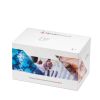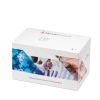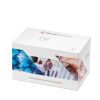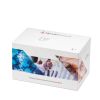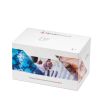LBP, Mouse, ELISA kit – 1 x 96 det. - HK205-01
Quantity
1 x 96 det.
Catalog #
HK205-01
778,00 €
Lipopolysaccharide (LPS) Binding Protein (LBP) is a type 1 acute phase protein that is constitutively produced by the liver and rapidly upregulated during the acute phase response. LBP plays a central role in the response to LPS. The protein catalyses the monomerization of LPS and its transfer to (s)CD14 and to lipoproteins. In this way LBP has both a role in the activation pathway of LPS: activation of monocytes by LPS leading to release of inflammatory mediators and in the neutralization of LPS i.e. the uptake of LPS by lipoprotein and subsequent clearing. The assay can be used to quantify LBP in tissue culture supernatants of mouse cell cultures and in plasma and serum samples. In plasma of normal mice LBP is present at levels of approx. 6 µg/ml, which increase approx. 10-fold during acute phase responses.
| Datasheet URL | https://www.hycultbiotech.com/wp-content/uploads/2022/06/HK205-1116.pdf |
|---|---|
| Quantity | 1 x 96 det. |
| Quantity | 1 x 96 det. |
| Standard range | The measurable concentration range is 0.8 -50 ng/ml. |
| Detection level | The minimum concentration which can be measured is 0.8 ng/ml mouse LBP. |
| Working volume | 100 µl/well |
| Species | mouse |
| Application | The mouse LBP ELISA kit is to be used for the in vitro quantitative determination of mouse LBP in serum, plasma and cell culture samples. |
| Principle | The mouse LBP ELISA is a ready-to-use solid-phase enzyme-linked immunosorbent assay based on the sandwich principle with a working time of 3½ hours. The efficient format of a plate with twelve disposable 8-well strips allows free choice of batch size for the assay. Samples and standards are captured by a solid bound specific antibody. Biotinylated tracer antibody will bind to captured LBP. Streptavidin-peroxidase conjugate will bind to the biotinylated tracer antibody. Streptavidin-peroxidase conjugate will react with the substrate, tetramethylbenzidine (TMB). The enzyme reaction is stopped by the addition of citric acid. The absorbance at 450 nm is measured with a spectrophotometer. A standard curve is obtained by plotting the absorbance (linear) versus the corresponding concentrations of the mouse LBP standards (log). The mouse LBP concentration of samples, which are run concurrently with the standards, can be determined from the standard curve. |
| Storage and stability | Product should be stored at 4 °C. Under recommended storage conditions, product is stable for at least six months. |
| Precautions | For research use only. Not for use in or on humans or animals or for diagnostics. It is the responsibility of the user to comply with all local/state and Federal rules in the use of this product. Hycult Biotech is not responsible for any patent infringements that might result with the use of or derivation of this product. |
| References | 1. Tiirola, T et al; Effect of acute Chlamydia pneumoniae infection on lipoprotein metabolism in NIH/S mice. Scand J Clin Lab Invest 2002, 62: 477 2. Branger, J et al; LPS-binding protein-deficient mice have an impaired defense against Gram-negative but not Gram-positive pneumonia. Int Immunol 2004, 16: 1605 3. Matsumoto, A et al; Effects of 5-week ethanol feeding on the liver of aldehyde dehydrogenase 2 knockout mice. Parmacogenet Genomics 2008, 18: 847 |
| Disease | Infectious diseases |
| Application assays: | The mouse LBP ELISA kit is to be used for the in vitro quantitative determination of mouse LBP in serum, plasma and cell culture samples. |
|---|---|
| Principle: | The mouse LBP ELISA is a ready-to-use solid-phase enzyme-linked immunosorbent assay based on the sandwich principle with a working time of 3½ hours. The efficient format of a plate with twelve disposable 8-well strips allows free choice of batch size for the assay. Samples and standards are captured by a solid bound specific antibody. Biotinylated tracer antibody will bind to captured LBP. Streptavidin-peroxidase conjugate will bind to the biotinylated tracer antibody. Streptavidin-peroxidase conjugate will react with the substrate, tetramethylbenzidine (TMB). The enzyme reaction is stopped by the addition of citric acid. The absorbance at 450 nm is measured with a spectrophotometer. A standard curve is obtained by plotting the absorbance (linear) versus the corresponding concentrations of the mouse LBP standards (log). The mouse LBP concentration of samples, which are run concurrently with the standards, can be determined from the standard curve. |



